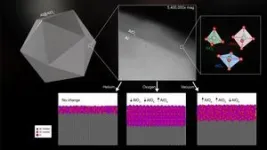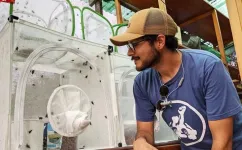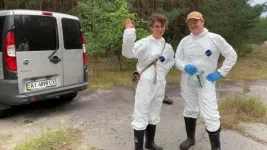(Press-News.org) HOUSTON – (March 5, 2024) – Catalysts unlock pathways for chemical reactions to unfold at faster and more efficient rates, and the development of new catalytic technologies is a critical part of the green energy transition.
The Rice University lab of nanotechnology pioneer Naomi Halas has uncovered a transformative approach to harnessing the catalytic power of aluminum nanoparticles by annealing them in various gas atmospheres at high temperatures.
According to a study published in the Proceedings of the National Academy of Sciences, Rice researchers and collaborators showed that changing the structure of the oxide layer that coats the particles modifies their catalytic properties, making them a versatile tool that can be tailored to suit the needs of different contexts of use from the production of sustainable fuels to water-based reactions.
“Aluminum is an earth-abundant metal used in many structural and technological applications,” said Aaron Bayles, a Rice doctoral alum who is a lead author on the paper. “All aluminum is coated with a surface oxide, and until now we did not know what the structure of this native oxide layer on the nanoparticles was. This has been a limiting factor preventing the widespread application of aluminum nanoparticles.”
Aluminum nanoparticles absorb and scatter light with remarkable efficiency due to surface plasmon resonance, a phenomenon that describes the collective oscillation of electrons on the metal surface in response to light of specific wavelengths. Like other plasmonic nanoparticles, the aluminum nanocrystal core can function as a nanoscale optical antenna, making it a promising catalyst for light-based reactions.
“Almost every chemical, every plastic that we use on a day-to-day basis, came from a catalytic process, and many of these catalytic processes rely on precious metals like platinum, rhodium, ruthenium and others,” Bayles said.
“Our ultimate goal is to revolutionize catalysis, making it more accessible, efficient and environmentally friendly,” said Halas, who is a University Professor, Rice’s highest academic rank. “By harnessing the potential of plasmonic photocatalysis, we’re paving the way for a brighter, more sustainable future.”
The Halas group has been developing aluminum nanoparticles for plasmonic photocatalysis reactions such as decomposition of dangerous chemical warfare agents and efficient production of commodity chemicals. The newly uncovered ability to modify the surface oxides on aluminum nanoparticles further increases their versatility for use as catalysts to efficiently convert light into chemical energy.
“If you’re doing a catalytic reaction, the molecules of the substance you’re looking to transform will interact with the aluminum oxide layer rather than with the aluminum metal core, but that metallic nanocrystal core is uniquely able to absorb light very efficiently and convert it into energy, while the oxide layer fulfills the role of a reactor, transferring that energy to reactant molecules,” Bayles said.
The properties of the nanoparticles’ oxide coating determine how they interact with other molecules or materials. The study elucidates the structure of this native oxide layer on aluminum nanoparticles and shows that simple thermal treatments ⎯ i.e. heating the particles to temperatures of up to 500 degrees Celsius (932 Fahrenheit) in different gasses ⎯ can change its structure.
“The crystalline phase, intraparticle strain and defect density can all be modified by this straightforward approach,” Bayles said. “Initially, I was convinced that the thermal treatments did nothing, but the results surprised me.”
One of the effects of the thermal treatments was to make the aluminum nanoparticles better at facilitating the conversion of carbon dioxide into carbon monoxide and water.
“Changing the alumina layer in this manner affects its catalytic properties, particularly for light-driven carbon dioxide reduction, which means the nanoparticles could be useful for producing sustainable fuels,” said Bayles, who is now a postdoctoral researcher at the National Renewable Energy Laboratory.
Bayles added that the ability “to use abundant aluminum in place of precious metals could be hugely impactful to combat climate change and opens the way for other materials to be similarly enhanced.”
“It was relatively easy to do these treatments and get big changes in catalytic behavior, which is surprising because aluminum oxide is famously not reactive ⎯ it is very stable,” Bayles said. “So for something that is a little bit more reactive ⎯ like titanium oxide or copper oxide ⎯ you might see even bigger effects.”
The research was supported by the Air Force Office of Scientific Research (FA9550-15-1-0022), the Defense Threat Reduction Agency (HDTRA1-16-1-0042), the National Science Foundation (1449500, 1905757, 2239545), the Robert A. Welch Foundation (C-1220, C-1222, C-2065), the Department of Defense SMART Scholarship and Fulbright Colombia-Pasaporte a la Ciencia.
-30-
This release can be found online at news.rice.edu.
Follow Rice News and Media Relations via Twitter @RiceUNews.
Peer-reviewed paper:
Tailoring the Aluminum nanocrystal surface oxide for all-Aluminum-based antenna-reactor plasmonic photocatalysts | PNAS | DOI: 10.1073/pnas.2321852121
Authors: Aaron Bayles, Catherine Fabiano, Chuqiao Shi, Lin Yuan, Yigao Yuan, Nolan Craft, Christian Jacobson, Parmeet Dhindsa, Adebola Ogundare, Yelsin Mendez Camacho, Banghao Chen, Hossein Robatjazi, Yimo Han, Geoffrey Strouse, Peter Nordlander, Henry Everitt and Naomi Halas
https://doi.org/10.1073/pnas.2321852121
Image downloads:
https://news-network.rice.edu/news/files/2024/02/AIB_5169-1bf0d1dc28f1424e.jpg
CAPTION: Aaron Bayles is a Rice University doctoral alum, a postdoctoral researcher at the National Renewable Energy Laboratory and a lead author on a paper published in the Proceedings of the National Academy of Sciences. (Photo courtesy of Aaron Bayles/Rice University)
https://news-network.rice.edu/news/files/2024/02/Al-Oxide-img-d5e0df44d7835009.jpg
CAPTION: The top half of the image shows a schematic illustration of an aluminum oxide nanoparticle (left), a microscope image of the oxide layer coating the surface of the nanoparticle (middle) and a representation of the different units in the alumina layer composition (right). The bottom half illustrates the effect of annealing on the oxide structure, which changes the thickness and arrangement of the atoms, resulting in modified optical and surface chemical properties of the aluminum nanoparticles. (Image courtesy of Aaron Bayles/Rice University)
https://news-network.rice.edu/news/files/2024/02/240207_Halas_Fitlow_034-f0ee9f28c85d729b.jpg
CAPTION: Naomi Halas is Rice University Professor and a professor of electrical and computer engineering, chemistry, bioengineering, physics and astronomy and materials science and nanoengineering. (Photo by Jeff Fitlow/Rice University)
Links:
Halas Research Group: https://halas.rice.edu/
Department of Electrical and Computer Engineering: https://eceweb.rice.edu/
Department of Chemistry: https://chemistry.rice.edu/
Department of Bioengineering: https://bioengineering.rice.edu/
Department of Physics and Astronomy: https://physics.rice.edu/
Department of Materials Science and Nanoengineering: https://msne.rice.edu/
Smalley-Curl Institute: https://sci.rice.edu/
About Rice:
Located on a 300-acre forested campus in Houston, Rice University is consistently ranked among the nation’s top 20 universities by U.S. News & World Report. Rice has highly respected schools of architecture, business, continuing studies, engineering, humanities, music, natural sciences and social sciences and is home to the Baker Institute for Public Policy. With 4,574 undergraduates and 3,982 graduate students, Rice’s undergraduate student-to-faculty ratio is just under 6-to-1. Its residential college system builds close-knit communities and lifelong friendships, just one reason why Rice is ranked No. 1 for lots of race/class interaction, No. 2 for best-run colleges and No. 12 for quality of life by the Princeton Review. Rice is also rated as a best value among private universities by Kiplinger’s Personal Finance.
If you do not wish to receive news releases from Rice University, reply to this email and write “unsubscribe” in the subject line. Office of News and Media Relations – MS 300, Rice University, 6100 Main St., Houston, TX 77005.
END
Aluminum nanoparticles make tunable green catalysts
Rice-developed method can modify aluminum nanoparticles’ catalytic properties
2024-03-05
ELSE PRESS RELEASES FROM THIS DATE:
Electrolyte cation types control electrochemical reactions on an electrode surface
2024-03-05
1. An international research group consisting of NIMS and the Finnish University of Jyväskylä has discovered through its electrode-electrolyte system research that electron and proton (i.e., hydrogen ion) transfer mechanisms during oxygen reduction reactions (ORRs) on electrode surfaces vary depending on the types of cations dissolved in the electrolytic solution. These results suggest that the energy conversion efficiencies and selectivity of electrochemical systems (e.g., fuel cells and water electrolysis hydrogen production systems) can be improved by selecting optimal reaction pathways and that this could be achieved without using expensive electrode ...
The dangers of misaligned product co-development contracts—and how they can derail innovation in high-tech firms
2024-03-05
Researchers from Mansoura University and University of Guelph published a new Journal of Marketing study that examines how misaligned contracts can erode innovation outcomes of high-tech firms.
The study, forthcoming in the Journal of Marketing, is titled “Collaborating to Innovate: Balancing Strategy Dividend and Transactional Efficiencies” and is authored by Nehal Elhelaly and Sourav Ray.
When a giant multinational like Unilever partners with one of its major suppliers, such as the industrial enzyme-producer Novozyme, the collaboration can fast-track ...
New publication highlights urgency of parasitic wasp release to save native bird
2024-03-05
DENVER/March 5, 2024 – Researchers with the University of Minnesota, funded by Morris Animal Foundation, hope to release highly-specialized parasitic wasps to serve as a biological control method to save Darwin’s finches from a dire threat: the invasive avian vampire fly, Philornis downsi.
This species has been devastating finch populations on the Galapagos Islands by laying eggs in their nests, with the emerging larvae harming the nestlings.
To protect these iconic birds and other endemic species impacted by the fly, ...
Tiny worms tolerate chornobyl radiation
2024-03-05
The 1986 disaster at the Chornobyl nuclear power plant transformed the surrounding area into the most radioactive landscape on Earth. Humans were evacuated, but many plants and animals continue to live in the region, despite the high levels of radiation that persist nearly four decades later.
A new study led by researchers at New York University finds that exposure to chronic radiation from Chornobyl has not damaged the genomes of microscopic worms living there today—which doesn’t mean that the region is safe, the scientists caution, but suggests that these worms are exceptionally resilient.
In ...
Restoration of degraded areas in semi-arid region contributes to ‘return’ of soil microorganisms, study shows
2024-03-05
Strategies deployed for the restoration of degraded land have had promising results in Brazil’s semi-arid region, improving the microbial properties of the soil and contributing to a return of native ecosystem services. The techniques include removal of cattle or restriction of their access to specific areas of pasture; cultivation of cover crops; and terracing to control erosion. Recovery of soil microbial properties maintains biodiversity and raises crop yields, contributing to agricultural ...
New research details negative consumer impacts of BLM support on major companies and brands
2024-03-05
INFORMS Journal Marketing Science New Study Key Takeaways:
Brands that supported BLM on social media during the height of the movement suffered negative impacts on social media.
Negative impacts were felt from both Democratic and Republican consumers.
The ‘bandwagon effect’ was one of the more significant factors.
Some brands with more historical prosocial posting on social media and socially oriented missions suffer less from the negative effects and may even benefit from supporting ...
Having self-control leads to power
2024-03-05
Out-of-control behavior by CEOs and other powerful people constantly makes headlines – so much so that some might consider impulsivity a pathway to power. New research from the UC San Diego Rady School of Management and Texas A&M University finds that having self-control is often what leads to power.
In a paper published in the Journal of Personality and Social Psychology, researchers find that showing self-control influences how powerful an individual is perceived to be by their peers, as well as how much power they are granted by those peers. In a series of seven experiments with roughly 3,500 participants, both students ...
Endocrine Society elects Lange as 2025-2026 President
2024-03-05
WASHINGTON—Endocrine Society members elected Carol Lange, Ph.D., of the University of Minnesota in Minneapolis, Minn., as its 2025-2026 President. She will serve as President-Elect for a year beginning in June 2024 before becoming President in June 2025.
Lange is a Professor of Medicine and Molecular Pharmacology and Therapeutics, holds the Tickle Family Land Grant Endowed Chair of Breast Cancer Research, and is the Associate Director for Basic Science and the Director of the Molecular, Genetic, and Cellular Targets of Cancer Training Program at the University of Minnesota Masonic ...
March issues of APA journals cover new insights into treatments for anxiety, depression, substance use disorder, ADHD and more
2024-03-05
WASHINGTON, D.C., March 5, 2024 — The latest issues of two American Psychiatric Association journals, The American Journal of Psychiatry and Psychiatric Services are now available online.
The March issue of The American Journal of Psychiatry features studies that focus on new insights into treatments across the lifespan. Highlights include:
Normalization of Fronto-Parietal Activation by Cognitive-Behavioral Therapy in Unmedicated Pediatric Patients With Anxiety Disorders. (AJP Deputy Editor ...
Does iron accumulate in brain after concussions?
2024-03-05
EMBARGOED FOR RELEASE UNTIL 4 P.M. ET, TUESDAY, MARCH 5, 2024
MINNEAPOLIS – People who have headaches after experiencing concussions may also be more likely to have higher levels of iron in areas of the brain, which is a sign of injury to brain cells, according to a preliminary study released today, March 5, 2024, that will be presented at the American Academy of Neurology’s 76th Annual Meeting taking place April 13–18, 2024, in person in Denver and online.
“These results suggest that iron accumulation in the brain can be used as a biomarker for concussion and post-traumatic ...
LAST 30 PRESS RELEASES:
Antibiotic resistance is ancient, ecological, and deeply connected to human activity, new review shows
Vapes, pouches, heated tobacco, shisha, cigarettes: nicotine in all forms is toxic to the heart and blood vessels
From powder to planet: University of Modena engineers forge a low-carbon future for advanced metal manufacturing
Super strain-resistant superconductors
Pre-school health programme does not improve children’s diet or physical activity, prompting call for policy changes, study finds
Autumn clock change linked to reduction in certain health conditions
AI images of doctors can exaggerate and reinforce existing stereotypes
Where medicine meets melody – how lullabies help babies and parents in intensive care
We may never be able to tell if AI becomes conscious, argues philosopher
AI video translation shows promise but humans still hold the edge
Deep ocean earthquakes drive Southern Ocean’s massive phytoplankton blooms, study finds
Without campus leftovers to pick through, the beaks of this bird changed shape during the pandemic
High-dose antibiotic does not reduce mortality in tuberculous meningitis
How many insects fly in the sky above the USA?
Could cheese protect your brain health?
Who faces more difficulty recovering from stroke?
Colliding galaxies create the brightest, fastest growing black holes at their center
New BrainHealth research reveals tradeoffs on sleep with cannabis use for chronic pain
Aging-US now on ResearchGate, enhancing visibility for authors and readers
'Molecular glue' stabilizes protein that inhibits development of non-small cell lung cancer
Mount Sinai Health System is recognized in 2025 Chime Digital Health Most Wired survey
From prey to predator: How carnivores spread beneficial fungi
Menopause symptoms may be frequent and have negative effects, according to female endurance athletes
US Congressmembers’ responses on X to mass shooting events differ along party lines
KAIST-UEL team develops “origami” airless wheel to explore lunar caves
Individual genetic differences render some therapies ineffective
Engineering dendritic cells boosts cancer immunotherapy
Sophisticated neuroimaging reveals PTSD in WTC responders is linked to measurable physical changes in brain structure
Health policy experts identify promising strategies for providing health care to homeless people
Study explores role of neutrophils in canine atopic dermatitis
[Press-News.org] Aluminum nanoparticles make tunable green catalystsRice-developed method can modify aluminum nanoparticles’ catalytic properties






